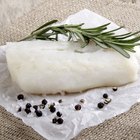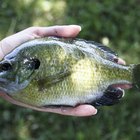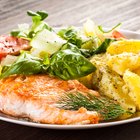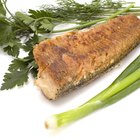
Catfish is a traditional favorite through most of the Southern states, and high-quality farmed catfish is now available all across the country. The catfish your kids catch can vary widely in flavor, depending on their diet and the quality of the water they lived in, but farmed fish have a consistently clean, sweet flavor. One of the simplest ways to prepare catfish is by baking fillets in your oven.
Catfish 101
Catfish can grow to be very large in the wild, and anglers at almost any big river cheerfully swap tales of bathtub-sized river monsters that have been caught -- or memorably escaped -- along their favorite stretch of water. Farmed channel catfish, the most common variety, are harvested at an average weight of about 1 1/2 pounds. That usually means fillets in the eight- to 12-ounce range, suitable for two to three portions. Your baking time for catfish fillets varies, depending on their thickness and the heat of your oven.
High-Temperature Baking
Relatively thin fillets of catfish, 1 inch or less at the thickest point, cook quickly enough to tolerate relatively high oven temperatures. Preheat your oven to 400 or 425 degrees Fahrenheit, and lay out the fillets on a sheet pan lined with foil or parchment. Your portions will cook in approximately six to 10 minutes, too quickly for the high heat to toughen the delicate flesh. The surface of the fillets will dry slightly, so protect the fillets by spraying them with oil or dotting them with butter. The quick cooking time means breading and other toppings won't have time to brown, so they should be avoided.
Conventional Baking
Thicker portions of catfish benefit from lower oven temperatures, which allow time for the middle to cook without drying and toughening the surface of the fillets. At 375 degrees F, allow approximately 10 minutes per 1 inch of thickness, with extra-large fillets sometimes requiring a few additional minutes. This is long enough to provide some gentle browning if you like your fillets breaded, but if necessary, use your broiler during the last minute or two to give the crumbs a golden-brown color.
Baking in Sauce
Baking ordinarily cooks the catfish in a dry heat, but some chefs and home cooks prefer to bake the fillets in a sauce. Technically, this is poaching rather than baking, but the result is an especially tender and flavorful meal. Line the bottom of a shallow casserole or baking dish with the sauce, and then lay your fillets on the sauce in a single layer and drizzle them with more sauce. If the sauce is cold when you assemble the dish, it will increase your cooking time by two to three minutes per inch of thickness. If it's hot, your cooking time will be approximately the same.
Related Articles
How to Cook a Turbot in the Oven

How to Cook Kingklip

How to Cook Monchong Fish
How to Cook Seasoned Keta Salmon

How to Cook a Pork Loin Fillet

How to Cook Rockfish Fillets

How to Cook Panfish in the Oven
How to Cook Haddock Loin Fillets

How to Bake a Frozen Halibut Fillet

How to Defrost Cod

How to Cook Bluegill Fish

How to Cook Steelhead Trout

Can You Eat the Skin on Grilled Trout?

How to Cook Pickerel in the Oven

How to Cook a Turbot Fillet

How to Pan Fry Tasty Perch Fillets

How to Bake a Frozen Halibut Filet

How to Freeze Cod Fish

How to Cook Tilefish

How to Make Sardines and Mackerel
References
- Professional Cooking; Wayne Gisslen
Writer Bio
Fred Decker is a trained chef and certified food-safety trainer. Decker wrote for the Saint John, New Brunswick Telegraph-Journal, and has been published in Canada's Hospitality and Foodservice magazine. He's held positions selling computers, insurance and mutual funds, and was educated at Memorial University of Newfoundland and the Northern Alberta Institute of Technology.
Photo Credits
Tim Boyle/Getty Images News/Getty Images